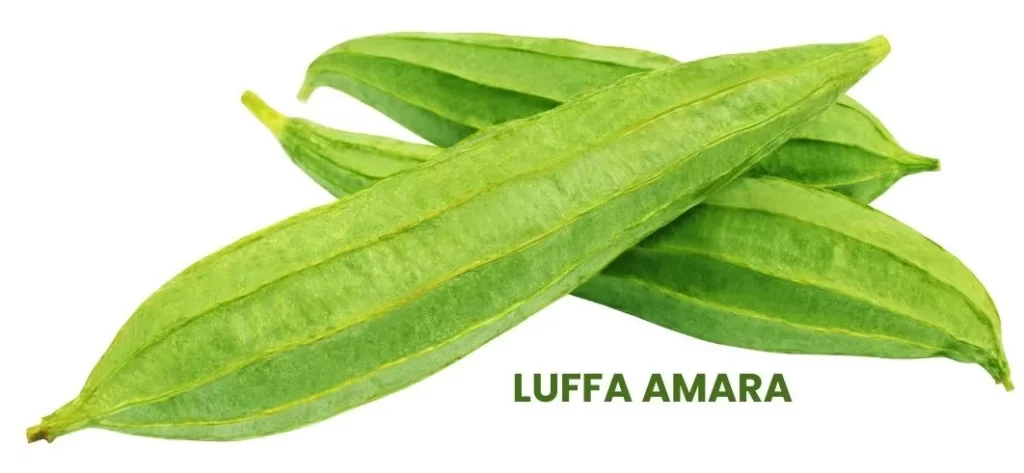Luffa Amara, commonly known as Titpolla, belongs to the Cucurbitaceae family.
It is traditionally used for its medicinal properties, particularly in treating conditions like an enlarged spleen, fever, and hepatic congestion.
Additionally, it is recognized for its tonic properties.

Table of Contents
ToggleSOURCE INFORMATION
Scientific Classification
- Kingdom: Plantae
- Clade: Angiosperms
- Clade: Eudicots
- Order: Cucurbitales
- Family: Cucurbitaceae
- Genus: Luffa
- Species: L. amara
Origin and Historical Facts
Luffa Amara is native to tropical regions and has been used in traditional medicine for centuries.
It is particularly noted in Ayurvedic and traditional Chinese medicine for its beneficial effects on the spleen and liver.
The plant is also utilized as a general tonic to improve overall health and vitality.
- Geographic Distribution: Commonly found in tropical and subtropical regions.
- Active Constituents: Contains saponins, flavonoids, and various alkaloids contributing to its medicinal properties.
- Pharmacological Properties: Antipyretic, hepatoprotective, tonic, and digestive aid.
DRUG PATHOGENESIS
- Luffa Amara primarily affects the digestive system, spleen, and liver.
- It is also noted for its effects on the circulatory system, particularly in conditions involving fever and weakness.
KEY CHARACTERISTICS
- Effective in treating an enlarged spleen and hepatic congestion.
- Acts as a general tonic, improving overall vitality and health.
- Treats fever and associated symptoms like burning sensation, thirst, and weakness.
DETAILED ORGAN SYMPTOMS
MIND
- Anxious: The patient often feels anxious and restless.
MOUTH
- Dry Mouth with Thirst: The patient experiences dryness in the mouth along with excessive thirst.
- Bitter Taste: A persistent bitter taste in the mouth.
DIGESTIVE SYSTEM
- Stool: Frequent passing of loose, rice-watery stools, occurring every fifteen minutes.
- Vomiting: Vomitus is watery or bile-like, sometimes mixed with mucus. Vomiting may occur every half hour, often simultaneous with purging.
SENSATION
- Burning Sensation: A burning sensation all over the body, occasionally accompanied by chilliness.
PULSE
- Feeble and Weak Pulse: The pulse is generally weak and feeble, indicating overall debility.
GENERAL BODY SYMPTOMS
- Cold with Perspiration: The body feels cold to touch, often accompanied by perspiration.
MODALITIES
- Worse: During fever, with burning sensations, and weakness.
- Better: With rest and adequate hydration.
WHAT ARE MODALITIES IN HOMOEOPATHY?
RELATIONSHIP WITH OTHER DRUGS
- Complementary: Remedies that support liver and spleen function, such as Carduus Marianus and Chelidonium.
- Similar: Remedies used for treating fevers and gastrointestinal issues, such as Arsenicum Album and Veratrum Album.
DOSE
- Potency of Choice: Mother tincture, 3x, 6x.
Frequently Asked Questions
How is Luffa Amara used in treating hepatic congestion?
- Luffa Amara helps reduce hepatic congestion by improving liver function and alleviating symptoms like discomfort and enlargement.
Can Luffa Amara be used for fever?
- Yes, Luffa Amara is effective in treating fevers, particularly those with symptoms like a burning sensation, excessive thirst, and weakness.
What are the recommended potencies for Luffa Amara?
- The recommended potencies for Luffa Amara are mother tincture, 3x, and 6x.
Are there any side effects of using Luffa Amara?
- Generally well-tolerated, but excessive use may cause gastrointestinal disturbances or allergic reactions in some individuals.
Glossary of Difficult Words
- Antipyretic: A substance that reduces fever.
- Hepatoprotective: A substance that protects the liver.
- Tonic: A substance that restores or improves health and vitality.
- Debility: Physical weakness, especially as a result of illness.
- Saponins: A group of naturally occurring plant glycosides that foam when shaken with water and have detergent or soap-like properties.
This comprehensive drug picture of Luffa Amara provides detailed information on its medicinal properties, historical usage, and recommended dosages.
